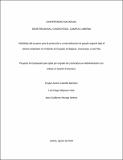| dc.contributor.advisor | Campos Campos, Diego | |
| dc.contributor.author | Castrillo Martínez, Deibys Andrés | |
| dc.contributor.author | Mejicano Ortiz, Luis Diego | |
| dc.contributor.author | Moraga Jiménez, Jesús Guillermo | |
| dc.date.accessioned | 2020-08-28T16:16:39Z | |
| dc.date.available | 2020-08-28T16:16:39Z | |
| dc.date.issued | 2020 | |
| dc.identifier.uri | http://hdl.handle.net/11056/18023 | |
| dc.description | Proyecto de Graduación para optar por el grado de Licenciatura en Administración con énfasis en Gestión Financiera. | es_ES |
| dc.description.abstract | La provincia de Guanacaste es una de las zonas en donde la actividad ganadera muestra gran relevancia, siendo considerada una de las principales actividades económicas. Por consiguiente, la presente investigación enmarca un estudio de viabilidad para un proyecto de ganadería, bajo un sistema no convencional (sistema estabulado), en el cual el ganado de engorde se mantiene en un establo, con una alimentación especial, que le permite un mejor desarrollo en un menor tiempo con respecto al ganado que se mantiene en pastoreo.
El proyecto está a cargo de Alonso Ramírez Pastos, quien es un ganadero de la zona de Guayabo, Guanacaste. Alonso Ramírez Pastos desarrolla la actividad ganadera bajo el sistema convencional, sin embargo, analiza la oportunidad de mejorar la actividad con un sistema más eficiente, en este caso, el estabulado. La idea es producir ganado de una mejor calidad, permitiéndole colocarlo en una planta ganadera a un precio competitivo.
La producción del ganado será de 30 reses por cuatrimestre para un total de 90 novillos gordos al año, se pretende que se alcance un peso de 550 kilogramos al final de los 4 meses, y será vendidos en la planta del Arreo como principal opción y de existir algún inconveniente se colocará en la planta de Montecillos.
El señor Alonso posee 5 hectáreas de terrenos de los cuales va a utilizar una para la construcción de la planta (establo) y las restantes serán usadas para el cultivo del pasto que será el maralfalfa para la alimentación de los animales, combinado con ensilaje.
El proyecto será financiado un 50% por préstamo bancario y el restante 50% por capital propio.
El ganado va a generar una gran cantidad de residuos con los cuales se pretende la elaboración de abono orgánico (lombrizcompost) que será usado para abonar el pasto | es_ES |
| dc.description.abstract | The province of Guanacaste is one of the areas where livestock farming shows great relevance, being considered one of the main economic activities. Therefore, the present research frames a feasibility study for a livestock project, under an unconventional system (stall system), in which the fattening cattle are kept in a stable, with a special diet, which allows them a better development in a shorter time with respect to cattle that are kept on pasture.
The project is in charge of Alonso Ramirez Pastos, who is a rancher from the Guayabo area, Guanacaste. Alonso Ramírez Pastos develops livestock activity under the conventional system, however, he analyzes the opportunity to improve the activity with a more efficient system, in this case, the stable. The idea is to produce better quality cattle, allowing you to place them in a cattle plant at a competitive price.
The production of the cattle will be 30 cattle per four-month period for a total of 90 fat steers per year, it is expected that a weight of 550 kilograms will be reached at the end of the 4 months, and will be sold at the Arreo plant as the main option and If there is any inconvenience, it will be placed in the Montecillos plant.
Mr. Alonso owns 5 hectares of land of which he will use one for the construction of the plant (stable) and the rest will be used for the cultivation of the pasture that will be the maralfalfa for feeding the animals, combined with silage.
The project will be financed 50% by bank loan and the remaining 50% by equity.
Livestock will generate a large amount of waste with which it is intended to make organic fertilizer (worm compost) that will be used to fertilize the grass. | es_ES |
| dc.description.sponsorship | Universidad Nacional, Costa Rica | es_ES |
| dc.language.iso | spa | es_ES |
| dc.publisher | Universidad Nacional, Costa Rica | es_ES |
| dc.rights | Acceso abierto | es_ES |
| dc.rights | Atribución-NoComercial-CompartirIgual 4.0 Internacional | * |
| dc.rights.uri | http://creativecommons.org/licenses/by-nc-sa/4.0/ | * |
| dc.subject | GANADO VACUNO | es_ES |
| dc.subject | GANADO DE CARNE | es_ES |
| dc.subject | ENGORDE | es_ES |
| dc.subject | FORRAJE | es_ES |
| dc.subject | ESTABULADO | es_ES |
| dc.subject | COMERCIALIZACIÓN | es_ES |
| dc.subject | GANADERÍA | es_ES |
| dc.subject | COSTA RICA | es_ES |
| dc.subject | GUANACASTE (COSTA RICA) | es_ES |
| dc.subject | BAGACES (GUANACASTE) | es_ES |
| dc.subject | ADMINISTRACIÓN | es_ES |
| dc.subject | FINANZAS | es_ES |
| dc.subject | TESIS | es_ES |
| dc.subject | CATTLE | es_ES |
| dc.subject | BEEF CATTLE | es_ES |
| dc.subject | FATTENING | es_ES |
| dc.subject | FORAGE | es_ES |
| dc.subject | FORAGE STABULATED | es_ES |
| dc.subject | COMMERCIALIZATION | es_ES |
| dc.subject | CATTLE RAISING | es_ES |
| dc.subject | ADMINISTRATION | es_ES |
| dc.subject | FINANCE | es_ES |
| dc.subject | THESIS | es_ES |
| dc.title | Viabilidad del proyecto para la producción y comercialización de ganado engorde bajo el sistema estabulado en el distrito de Guayabo de Bagaces, Guanacaste, Costa Rica | es_ES |
| dc.title.alternative | Feasibility of the project for the production and commercialization of fattening cattle under the stable system in the district of Guayabo de Bagaces, Guanacaste, Costa Rica | es_ES |
| dc.type | http://purl.org/coar/resource_type/c_7a1f | es_ES |
| dc.description.procedence | Sede Regional Chorotega- Campus Liberia | es_ES |


